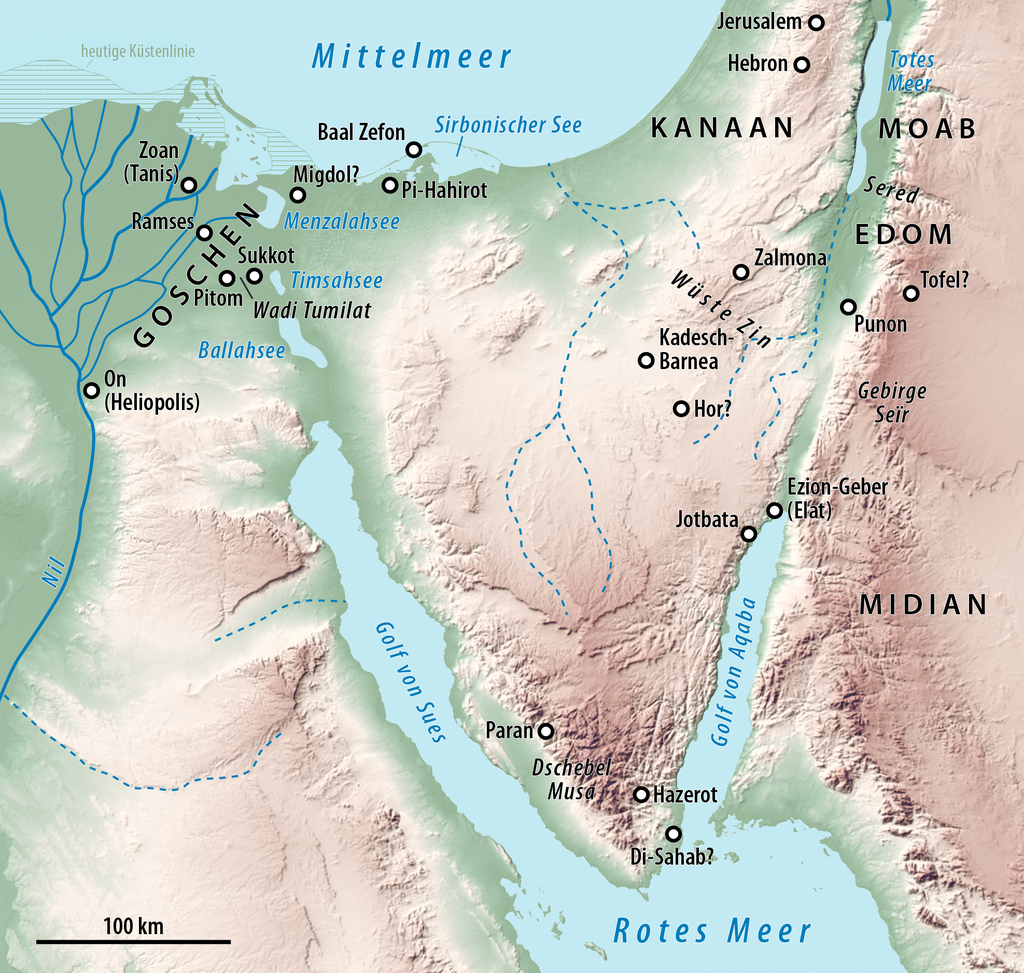Moses Parting the Red Sea: Myth or Miracle?

Written by Marko Marina, Ph.D.
Author | Historian | BE Contributor
Verified! See our guidelines
Verified! See our editorial guidelines
Date written: August 30th, 2023
Disclaimer: The views and opinions expressed in this article belong to the author and do not necessarily match my own. - Dr. Bart D. Ehrman
“Moses’ parting the Red Sea” – a phrase that conjures images of divine intervention, miraculous events, and a people’s liberation. This exceptional Biblical account, recounted through generations, captures the human imagination and fuels endless discussions.
But beneath the surface of this remarkable story lies a captivating question: Was it a factual event or a skillfully crafted work of fiction? In the following exploration, we get to the heart of this ancient narrative, navigating the tides of historical records, scientific inquiry, and the intricate interplay between belief and skepticism.

Tracing the Roots of Exodus: From the 10th Plague to the Promised Land
According to Exodus, God sent Moses to Pharaoh to demand that he let the Israelites leave Egypt. As a punishment for refusing, God then sent ten plagues on Egypt to punish Pharaoh. The plagues affected the harvest and undermined the Egyptian ruler’s authority.
However, Pharaoh remained steadfast until the 10th plague appeared. Yahweh told Moses that all of Egypt’s firstborn sons would be killed as revenge for the killing of Hebrew children a generation earlier.
At midnight, like clockwork, the attack began (Exod. 11, 1-9). The 10th plague launched as the shadow of death ran throughout Egypt, killing the cream of its youth. Every firstborn, including Pharaoh’s son on the throne and the prisoners in the dungeon, was affected. Only then did Pharaoh let Moses and the Israelites leave Egypt.
According to the Exodus, they went from Goshen through the Red Sea wilderness to Succoth (Exod. 13, 18-20). Following that route, they came to Ezion Geber. This was a logical route to take. If Moses had continued on that road, he would have reached the doorstep of the Promised Land in a matter of weeks.
However, something unexpected happened. God told Moses to turn back and camp between the Migdon and the Sea (Exod. 14, 1-3). Why? The answer is simple! Pharaoh changed his mind once again. Six hundred chariots boosted by cavalry units from all over Egypt were thundering across the desert in pursuit of the Hebrew fugitives.
This brings us to the famous moment when Moses lifted his staff and divided the sea, allowing the Israelites to pass on dry ground (Exod. 14, 21-22). When the last Hebrew reached the opposite bank, Moses stretched his hands again and closed the water, thus sending the Egyptian army to death.
When Did Moses Part the Red Sea?
If one were to approach the story from a historical-critical perspective, which seeks to understand the biblical texts against their ancient Near Eastern context, the event as described is typically placed in the narrative world of the Bible during the Late Bronze Age, around the 13th century BCE.
This dating aligns with what is known as the Exodus tradition, which some scholars suggest could be associated with the period of the New Kingdom of Egypt, particularly in the era of the 19th Dynasty, perhaps during the reign of Pharaoh Ramesses II. However, it's important to underscore that this is speculative. As we will see, there is no direct archaeological or historical evidence for the event itself or for the Israelites' presence in Egypt at that time.
Before we try to untangle and understand Moses' parting the Red Sea, let's talk about the location of that iconic moment.
Moses’ Parting the Red Sea: An Unsuccessful Search for The Location
Where did Moses cross the Red Sea? This question has puzzled historians and archaeologists for centuries. According to Exodus, Moses and Pharaoh met in a place called Yam Suph. How do we understand this term? Do we possess any Red Sea crossing evidence that points us to the exact location?
In the 19th century, scholars noted that the traditional translation (Yum Suph = Red Sea) was wrong. The proper translation should be the Sea of Reeds. Furthermore, they postulated the term denotes a marshy body of water somewhere in Egypt.
Consequently, scholars embarked on a quest to pinpoint the exact location of the Sea of Reeds.
Several hypotheses are suggested:
- Some scholars believe that the Sea of Reeds may refer to Lake Timash, a shallow lake of reeds.
- Heinrich K. Brugsch identifies the Sea of Reeds as the Lake Bardawill.
- In a recent article, Manfred Bietak and James K. Hoffmeier conclude the Sea of Reeds is Ballah Lakes.
Following a more traditional paradigm, others point to the Gulf of Aqaba (depicted in the picture below).
Despite their differences regarding the exact location, they all share the same basic proposition. Namely, a specific naturalistic methodology drives their search for a suitable location.

Curb Your Enthusiasm: Naturalistic Explanations for the Parting of the Sea
According to some scholars, Moses’ crossing of the Sea could be explained by the presence of lakes, without the need for miraculous interventions. In other words, these lakes were full of sandbanks, allowing the Israelites to cross from Egypt into the Sinai. However, Pharaoh’s chariots would have gotten stuck in the mud.
Therefore, they argue that Moses’ parting of the Red Sea is based on purely naturalistic circumstances.
Other scholars find different naturalistic explanations. In “The Parting of the Sea: How Volcanoes, Earthquakes, and Plagues Shaped the Story of Exodus,” Barbara J. Sivertsen argues that an eruption of a volcano off the Aegean island of Yali created a series of tsunamis that “parted the sea” and drowned the pursuing Egyptian army.
Post-enlightenment Attempts to Understand Pre-enlightenment Times
The main problem with the “Sea of Reeds” theory is that there is no record of an Egyptian place named Yam Suph. In cases where we find this phrase in the Egyptian sources, it only means a district, not a specific body of water.
As my previous post about Moses noted, scholars attempt to naturalize pre-modern sources and establish a historical basis for the Exodus account. This leads to multiple scientific explanations of Moses parting the Red Sea.
In his article “The Red Sea or Reed Sea? How the Mistake was Made and What Yam Suph Really Means,” Bernard Batto notes there is no specific location or body of water related to the term Yam Suph.
Similarly, in his Commentary on Exodus, Carol Meyers concludes that the “attempts to find a body of water compatible with all the references to the Sea of Reeds in the Exodus account as well as elsewhere in the Hebrew Bible have not succeeded.”

But wait! Did Moses’ Parting of the Sea Happen?
Where did Moses cross the Red Sea? What exactly happened? In my opinion, it is unwise to pin this saga on a particular historical event.
Today, most scholars believe oral traditions were compiled and documented between the 7th and 5th centuries BCE in what we today know as Exodus. Many stories about Egyptian workers migrating to Canaan were likely combined to create the Exodus saga.
Moreover, one block of stone offers a compelling piece of evidence. It’s called the Stele of King Merneptah, dated to 1207 BCE. Among its dense hieroglyphs is the first reference to an entity called “Israel.” Therefore, near the end of the 13th century BCE, a community known as Israel began to exist.
Therefore, Anne E. Kilebrew’s conclusion in Biblical Peoples and Ethnicity is worth quoting: “In light of the lack of evidence in the Egyptian texts and the archaeological remains of an exodus of this magnitude, it is not surprising that scholars have suggested that the exodus does not represent a specific historical moment but rather numerous “exoduses” that were “telescoped” into a single event.”
Furthermore, Moses’ parting of the Red Sea is portrayed in Exodus as a result of a miraculous event. As such, its details remain elusive to historians of the ancient world. As Bart observes in his blog article, miracles are, by definition, beyond the scope of historians who can only operate within the natural world.
Naturalizing Exodus Erases The Essense of the Account
By naturalizing the Exodus account, we lose the entire meaning of the narrative. The whole story is based on the belief that the plagues and Moses’ parting the Red Sea demonstrate God’s mighty hand by delivering his people from slavery.
Additionally, these naturalistic attempts at understanding Moses’ parting the Red Sea reflect a form of fundamentalism. They propose that everything in the Exodus happened as described but wasn’t miraculous.
Therefore, these explanations, as observed by Carol Meyers, “detract us from focusing on the significance of the miraculous rescue of the escaping Israelites.”
The naturalistic methodology applied to Exodus reminds me of the German scholar Heinrich G. Paulus (1761-1851.) He presented “rational” explanations for the New Testament miracles attributed to Jesus. His theory failed to find support among scholars.
It is wrong to ignore the source because it does not fit into our post-Enlightenment worldview. We forget the account’s essence by persistently searching for questionable naturalistic explanations.
MOSES PARTING THE RED SEA: Scholarly Conclusions
While the Exodus story is an iconic cornerstone of cultural and religious heritage, the veil of uncertainty shrouding its historical authenticity remains. How should we understand Moses’ parting of the Red Sea? Where did Moses cross the Red Sea?
This very ambiguity invites us to continue our pursuit of knowledge and understanding. Acknowledging the limitations of our vantage point, we find ourselves at a crossroads of curiosity and discovery.
For those who yearn to unravel the layers of history and delve into the intricate tapestry of Moses and his remarkable journey, we invite you to embark on a voyage of intellectual exploration. Join the “Finding Moses” course by Dr. Bart Ehrman, where the intricacies of Exodus and the figure of Moses are dissected from a scholarly perspective.
The waters of history may remain restless, but our pursuit of knowledge knows no bounds. Click the link below and join Dr. Ehrman in his scholarly analysis of Exodus and Moses.

